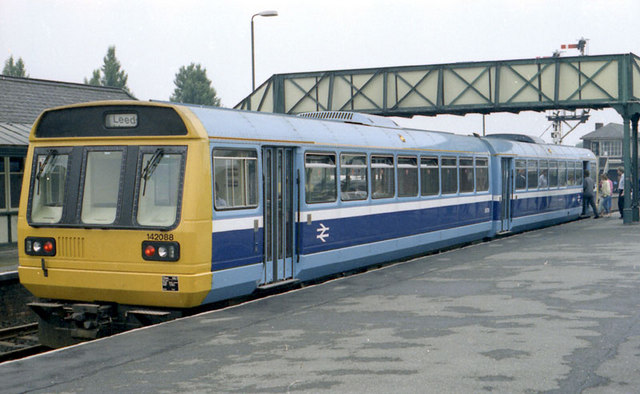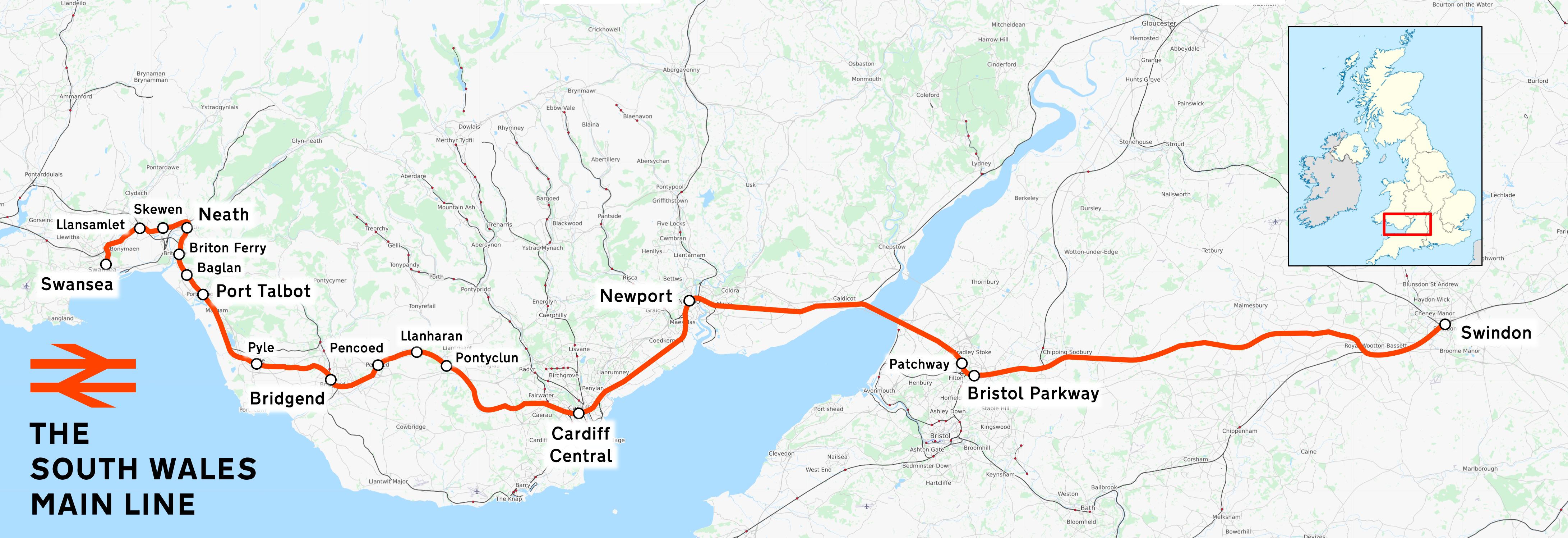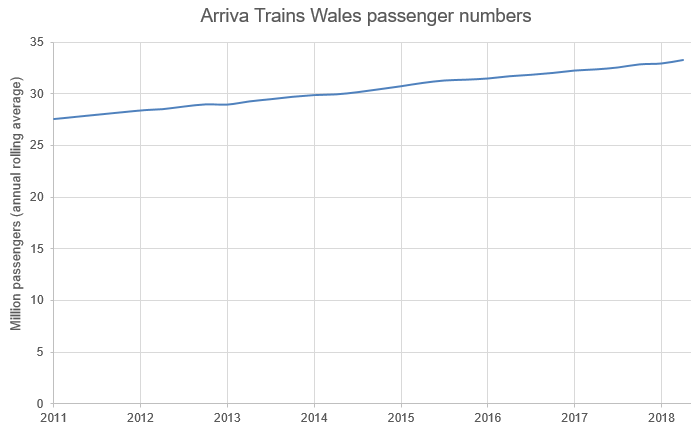|
Cardiff City Line
The Cardiff City Line is a commuter railway line in Cardiff that runs between and via . History The line was opened by the Taff Vale Railway in 1859, as part of its route from to the docks at Penarth. Subsequent construction by the TVR added links to and to the Extension Railway by 1878. Originally the line was freight-only, but over the years saw regular use for empty passenger trains thanks to its links with the depot at Cardiff Canton TMD and also for football specials to Ninian Park stadium and periodic engineering diversions. The first regular passenger service was introduced to the line on 5 October 1987, when three new stations were opened at , and , and regular service was introduced to the previously existing station. The new service was introduced by British Rail in co-operation with the Mid Glamorgan and South Glamorgan County Councils. Services There are currently trains every half hour which drop to every hour in the evenings on Mondays-Saturdays. ... [...More Info...] [...Related Items...] OR: [Wikipedia] [Google] [Baidu] |
British Rail Class 142
The British Rail Class 142 Pacer were diesel multiple units built for British Rail (BR) from 1985 to 1987. The class were built with a high level of commonality with the widely-used Leyland National bus. They are part of the Pacer family of railbuses. The last set was withdrawn from service in 2020. Background By the beginning of the 1980s, British Rail (BR) operated a large fleet of first-generation DMUs, which had been constructed in prior decades to various designs. While formulating its long-term strategy for this sector of its operations, British Rail planners recognised that considerable costs would be incurred by undertaking refurbishment programmes necessary for the continued use of these ageing multiple units, particularly due to the necessity of handling and removing hazardous materials such as asbestos. In the light of the high costs involved in retention, planners examined the prospects for the development and introduction of a new generation of DMUs to succeed th ... [...More Info...] [...Related Items...] OR: [Wikipedia] [Google] [Baidu] |
British Rail
British Railways (BR), which from 1965 traded as British Rail, was a state-owned company that operated most of the overground rail transport in Great Britain from 1948 to 1997. It was formed from the nationalisation of the Big Four British railway companies, and was privatised in stages between 1994 and 1997. Originally a trading brand of the Railway Executive of the British Transport Commission, it became an independent statutory corporation in January 1963, when it was formally renamed the British Railways Board. The period of nationalisation saw sweeping changes in the railway. A process of dieselisation and electrification took place, and by 1968 steam locomotives had been entirely replaced by diesel and electric traction, except for the Vale of Rheidol Railway (a narrow-gauge tourist line). Passengers replaced freight as the main source of business, and one-third of the network was closed by the Beeching cuts of the 1960s in an effort to reduce rail subsidies. On privatis ... [...More Info...] [...Related Items...] OR: [Wikipedia] [Google] [Baidu] |
Railway Lines In Wales
This is a list of railway lines in Great Britain that are currently in operation, split by country and region. There are a limited number of main inter-regional lines, with all but one entering Greater London. The line from London to the Channel Tunnel is the only line designated ' high speed', although the other main routes also operate limited-stop express services. The bulk of the secondary network is concentrated in London and the surrounding East and South East regions; an area marketed by National Rail as ''London and the South East''. The majority of these lines are radial to London. There is a further concentration of routes around Birmingham in the West Midlands and in the urbanised part of northern England that stretches from Liverpool in the west, via Greater Manchester to Leeds in the east. Some areas, such as Wales and Scotland, have relatively sparse railway provision. There are local lines throughout all areas of Great Britain with some services designated as c ... [...More Info...] [...Related Items...] OR: [Wikipedia] [Google] [Baidu] |
List Of Railway Stations In Cardiff
This is a list of railway stations in Cardiff, the capital of Wales. It only includes passenger heavy rail stations with timetabled services. Rail operators All 20 stations in Cardiff are owned by Network Rail and managed by Transport for Wales which also operates all train services at these stations, with the exception of Cardiff Central which is also served by CrossCountry and Great Western Railway. Stations The stations form part of Cardiff's commuter rail network, colloquially known as Valley Lines, with Cardiff Queen Street and Cardiff Central being the main hubs of the city. Cardiff Central is also one of the United Kingdom's major railway stations, providing connections to Newport, Bristol, Bath, London, Southampton, Portsmouth, Gloucester, Cheltenham, Birmingham and Nottingham. Cardiff Central continues to serve as major interchange on the British rail network, with 1,042,297 changes at the station in 08/09. Its passenger usage also increased by around 1.5 million to 11. ... [...More Info...] [...Related Items...] OR: [Wikipedia] [Google] [Baidu] |
South Wales Metro
The South Wales Metro () is an integrated heavy rail, light rail and bus-based public transport services and systems network in South East Wales around the hub of . The first phase was approved for development in October 2013. Works are currently underway with a brand new depot under construction at Taff's Well and new trains being constructed at the Construcciones y Auxiliar de Ferrocarriles (CAF) factory in Newport. This will also include the electrification of the core Valley Lines and new stations. This will be the biggest overhaul to the railways of South Wales since their construction 170 years ago. Background The rail-based transport system in South Wales was degraded due to the 1960s Beeching cuts. This saw the closure of some lines and many sub-branches serving the mainly ex-mining communities and their easy links to ports and resorts on the coast. Since 1987, five of the main closures have been reversed: services were reinstated on Cardiff's City Line that year, th ... [...More Info...] [...Related Items...] OR: [Wikipedia] [Google] [Baidu] |
Valleys & Cardiff Local Routes
Valleys & Cardiff Local Routes ( cy, Llwybrau Lleol y Cymoedd a Chaerdydd) (formerly Valley Lines) is the network of passenger suburban railway services radiating from Cardiff, Wales. It includes lines within the city itself, the Vale of Glamorgan and the South Wales Valleys. The services are currently operated by Transport for Wales Rail. In total, it serves 81 stations in six unitary authority areas: 20 in the city of Cardiff, 11 in the Vale of Glamorgan, 25 in Rhondda Cynon Taf, 15 in Caerphilly, 8 in Bridgend and 5 in Merthyr Tydfil. Services on these routes are provided by Class 150 DMUs, and Class 769 bi-mode multiple units in Diesel mode. They are typically end-to-end, in that they run from one branch terminus, through Cardiff Queen Street station, to another branch terminus, e.g. from Pontypridd to Barry Island. The major hubs of the network are and . Other hubs are , and . History A stretch of the Vale of Glamorgan Line, on which passenger services were clos ... [...More Info...] [...Related Items...] OR: [Wikipedia] [Google] [Baidu] |
South Wales Main Line
The South Wales Main Line ( cy, Prif Linell De Cymru), originally known as the London, Bristol and South Wales Direct Railway or simply as the Bristol and South Wales Direct Railway, is a branch of the Great Western Main Line in Great Britain. It diverges from the core London-Bristol line at Royal Wootton Bassett beyond Swindon, first calling at Bristol Parkway, after which the line continues through the Severn Tunnel into South Wales. Great Western Railway operates Class 800 trains between London and South Wales, and Classes 253, 254 and 255 High Speed Trains on services between Cardiff and South West England. CrossCountry provides services from Cardiff to Nottingham via Severn Tunnel Junction and thence the Gloucester to Newport Line via Gloucester and Birmingham. Transport for Wales operates services between South Wales, and North Wales and the Midlands on the line. The line between Wootton Bassett and Cardiff Central is electrified using the 25 kV AC overhead system, ... [...More Info...] [...Related Items...] OR: [Wikipedia] [Google] [Baidu] |
Electric Multiple Unit
An electric multiple unit or EMU is a multiple-unit train consisting of self-propelled carriages using electricity as the motive power. An EMU requires no separate locomotive, as electric traction motors are incorporated within one or a number of the carriages. An EMU is usually formed of two or more semi-permanently coupled carriages, but electrically powered single-unit railcars are also generally classed as EMUs. The great majority of EMUs are passenger trains, but versions also exist for carrying mail. EMUs are popular on commuter and suburban rail networks around the world due to their fast acceleration and pollution-free operation. Being quieter than diesel multiple units (DMUs) and locomotive-hauled trains, EMUs can operate later at night and more frequently without disturbing nearby residents. In addition, tunnel design for EMU trains is simpler as no provision is needed for exhausting fumes, although retrofitting existing limited-clearance tunnels to accommodate the ... [...More Info...] [...Related Items...] OR: [Wikipedia] [Google] [Baidu] |
Department For Transport
The Department for Transport (DfT) is a department of His Majesty's Government responsible for the English transport network and a limited number of transport matters in Scotland, Wales and Northern Ireland that have not been devolved. The department is run by the Secretary of State for Transport, currently (since 25 October 2022) Mark Harper. The expenditure, administration and policy of the Department for Transport are scrutinised by the Transport Committee. History The Ministry of Transport was established by the Ministry of Transport Act 1919 which provided for the transfer to the new ministry of powers and duties of any government department in respect of railways, light railways, tramways, canals and inland waterways, roads, bridges and ferries, and vehicles and traffic thereon, harbours, docks and piers. In September 1919, all the powers of the Road Board, the Ministry of Health, and the Board of Trade in respect of transport, were transferred to the new ministry. ... [...More Info...] [...Related Items...] OR: [Wikipedia] [Google] [Baidu] |
British Rail Sprinter
The Sprinter is a family of diesel multiple unit trains in use on the British railway system. They were built in the 1980s and early-1990s by British Rail Engineering Limited (BREL), Metro-Cammell and Leyland. Most have Cummins engines with Voith hydraulic transmissions, although 47 Class 158 units have Perkins engines instead. Sprinters can be seen operating in almost every part of Great Britain, from rural branch lines to commuter expresses into major cities. Originally British Rail coined the "Sprinter" name for the units, mainly to promote the superior acceleration capabilities of the units compared with the first-generation DMUs they replaced. Advertisements such as "The Sprinters are coming" were locally advertised in newspapers when these trains were scheduled to be introduced. Great play was also made of, in many cases, reduced journey times. Background By the beginning of the 1980s, British Rail (BR) operated a large fleet of first generation DMUs, which had been co ... [...More Info...] [...Related Items...] OR: [Wikipedia] [Google] [Baidu] |
Arriva Trains Wales
Arriva Trains Wales (ATW; cy, Trenau Arriva Cymru) was a British train operating company owned by Arriva UK Trains that operated the Wales & Borders franchise. It ran urban and inter-urban passenger services to all railway stations in Wales, including , , , , and , as well as to certain stations in England such as , , , Crewe railway station, Crewe, and . In August 2003, Arriva UK Trains was awarded the newly created Wales & Borders franchise by the Strategic Rail Authority, Arrival Trains Wales began operation during December 2003, taking over from Wales and Borders. Following the implementation of the Railways Act 2005 and Transport (Wales) Act 2006, responsibility for the franchise was devolved to the Welsh Government, which worked closely with Arriva Trains Wales during its period of operations. Numerous service changes were made under the company's management; on 6 February 2008, the Ebbw Valley Railway was partially re-opened to passenger services for the first time in ... [...More Info...] [...Related Items...] OR: [Wikipedia] [Google] [Baidu] |
Valley Lines
Valleys & Cardiff Local Routes ( cy, Llwybrau Lleol y Cymoedd a Chaerdydd) (formerly Valley Lines) is the network of passenger suburban railway services radiating from Cardiff, Wales. It includes lines within the city itself, the Vale of Glamorgan and the South Wales Valleys. The services are currently operated by Transport for Wales Rail. In total, it serves 81 stations in six unitary authority areas: 20 in the city of Cardiff, 11 in the Vale of Glamorgan, 25 in Rhondda Cynon Taf, 15 in Caerphilly, 8 in Bridgend and 5 in Merthyr Tydfil. Services on these routes are provided by Class 150 DMUs, and Class 769 bi-mode multiple units in Diesel mode. They are typically end-to-end, in that they run from one branch terminus, through Cardiff Queen Street station, to another branch terminus, e.g. from Pontypridd to Barry Island. The major hubs of the network are and . Other hubs are , and . History A stretch of the Vale of Glamorgan Line, on which passenger services were clo ... [...More Info...] [...Related Items...] OR: [Wikipedia] [Google] [Baidu] |

.jpg)




